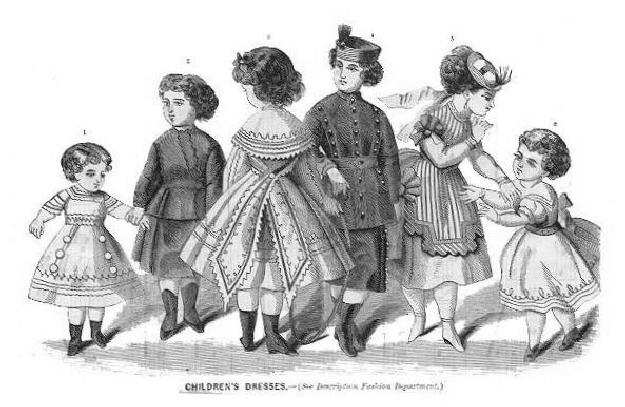
Godey's Lady's Book; Children's Dresses (United States, September 1868)

Figure 1.-- One important source of fashion information in the mid-19th century is Godey's Lady's Book. The September 1868 issue had a variety of outfits for younger children, both boys and girls. Younger boys and girls wore the same dresses. There wee dresses for somewhat older girls and kilt suits for the boys. Of course fashion magazines are not as good an indicator of popular fashions as catalogs, but are still a useful for source of information, escpecially because catalogs in the 1860s were not as common as they were to become in subsequent years.
|
|
One important source of fashion information in the mid-19th century is Godey's Lady's Book. The September 1868 issue had a variety of outfits for younger children, both boys and girls. Younger boys and girls wore the same dresses. There wee dresses for somewhat older girls and kilt suits for the boys. Of course fashion magazines are not as good an indicator of popular fashions as catalogs, but are still a useful for source of information, escpecially because catalogs in the 1860s were not as common as they were to become in subsequent years.
Godey's Ladies Book
The concept of the ladies magazine was first developed in Ameica by Sara Josepha Hale, editor of Godey's Lady's Book. She has been referred to as the “doyenne of 19th century manners. From 1837 to 1877 she slowly, with gentle words, aimed to make-over the Victorian personality and pave the way for the modernization of women. As editor she set the first trend in ladies magazines by developing "departments" such as health and fashion, which became known as a "formula." Unfortunately Sara would not see the real efforts of her hard work after retiring in 1877 and then passing on. But her influence appears to have transformed the generation coming of age in the 1880's when girls were reported to have started batteling their way into colleges in large numbers. By then it was apparent that a "modern" woman in America had been born. She was riding bikes, playing tennis, going to college, and becoming doctors and writers. With all these new changes in women, magazines had a lot to report on. After Godey's fell, changes in technology developed new
formulas for magazines, and fashion played a large role in this with the invention of the sewing machine & the sewing pattern. Godey's devoted some attention to children's fashions and issues. While a relatively small part of the magazine. The relative rarity of photographic images in the early years of publication make Godey's an extremely valuable resource.
Fashion Magazine
One important source of fashion information in the mid-19th century is fashion magazines and the most important is Godey's Lady's Book. Fashion magazines are not as good an indicator of popular fashions as catalogs, but are still a useful for source of information, escpecially because catalogs in the 1860s were not as common as they were to become in subsequent years.
Garments Depicted: Children's Dresses
The September 1868 issue had a variety of outfits for younger children, both boys and girls which they labeled "children's dresses". They are mostly skirted garments for boys and girls. Younger boys and girls wore the same dresses. There wee dresses for somewhat older girls and kilt suits for the boys.
Figure 1: Child dresses
The Godey's text read, "Dress for a child of three years old, of white pique', gored and trimmed with three rows of braid sewed on plain, with a narrow braiding pattern above. Three large buttons are placed on the side seams." Nore that heard "child" is used in the sence of a garment appropriate for both boys and girls to wear.
Figure 2: Boy's kilt suit
The Godey's text read, "Little boy's suit of Spanish linen, made with a skirt and blouse. The belt, neck, etc., is cut in points and bound with black braid."
Figure 3: Girl's dress
The Godey's text read, "Dress for a girl of six years old, of blue Chambray braided with white; low corsage, with Marie Antoinette fichu braided to match the skirt; the long ends are fastened in the back, and form a sash."
Figure 4: Boy's pants suit
The Godey's text read, "Suit for a boy of eight years old, of light casimere made Garibaldi pants and blouse. They are trimmed with bands of silk, with a row of buttons through the centre." This is a little confusing as it looks like a kilt suit. Actually they appear to be a kilt skirted garment. But they are Garabaldi pants cut very wide.
Figure 5: Girl's dress
The Godey's text read, "Dress for a girl of five years. The underskirt is of plain blue silk; the over-skirt and waist of blue and white striped silk; the bottom of skirt is cut in scallops, headed by a band of blue silk. A large bow of blue silk is fastened at each side. Hat of white chip, trimmed with blue velvet."
Figure 6: Child's dress
The Godey's text read, "Dress for a child of four years old, of pink cambric, braided with white. Sash of the same, braided to match."
HBC

Navigate the Boys' Historical Clothing catalog/magazine pages:
[Return to the Main American mail order 1868 page]
[Return to the Main American mail order 1860s page]
[Return to the Main U.S. catalog chronology page]
[Main photo/publishing page]
[Store catalogs]
[Fashion magazines]
[Patterns]
Navigate the Boys' Historical Clothing Web Site:
[Introduction]
[Activities]
[Biographies]
[Chronology]
[Cloth and textiles]
[Clothing styles]
[Countries]
[Topics]
[Bibliographies]
[Contributions]
[FAQs]
[Glossaries]
[Images]
[Links]
[Registration]
[Tools]
[Boys' Clothing Home]
Navigate the Boys' Historical Clothing Web Site:
[Headwear]
[Sailor hats]
[Glengary bonnet]
[Dresses]
[Kilts]
[Buster Brown suits]
[Eton suits]
[Sailor suits]
[Rompers]
[Tunics]
[Smocks]
[Pinafores]
[Coats]
[Long stockings]
[Leggings]
[Underwear]
Created: 7:19 PM 9/25/2008
Last updated: 7:19 PM 9/25/2008



